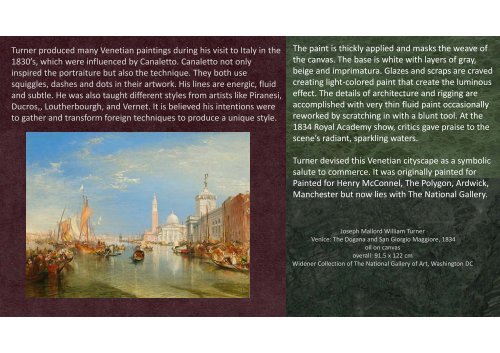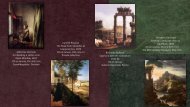You also want an ePaper? Increase the reach of your titles
YUMPU automatically turns print PDFs into web optimized ePapers that Google loves.
Turner produced many Venetian paintings during his visit to Italy in the<br />
1830’s, which were influenced by Canaletto. Canaletto not only<br />
inspired the portraiture but also the technique. They both use<br />
squiggles, dashes and dots in their artwork. His lines are energic, fluid<br />
and subtle. He was also taught different styles from artists like Piranesi,<br />
Ducros,, Loutherbourgh, and Vernet. It is believed his intentions were<br />
to gather and transform foreign techniques to produce a unique style.<br />
The paint is thickly applied and masks the weave of<br />
the canvas. The base is white with layers of gray,<br />
beige and imprimatura. Glazes and scraps are craved<br />
creating light‐colored paint that create the luminous<br />
effect. The details of architecture and rigging are<br />
accomplished with very thin fluid paint occasionally<br />
reworked by scratching in with a blunt tool. At the<br />
1834 Royal Academy show, critics gave praise to the<br />
scene’s radiant, sparkling waters.<br />
Turner devised this Venetian cityscape as a symbolic<br />
salute to commerce. It was originally painted for<br />
Painted for Henry McConnel, The Polygon, Ardwick,<br />
Manchester but now lies with The National Gallery.<br />
Joseph Mallord William Turner<br />
Venice: The Dogana and San Giorgio Maggiore, 1834<br />
oil on canvas<br />
overall: 91.5 x 122 cm<br />
Widener Collection of The National Gallery of Art, Washington DC





